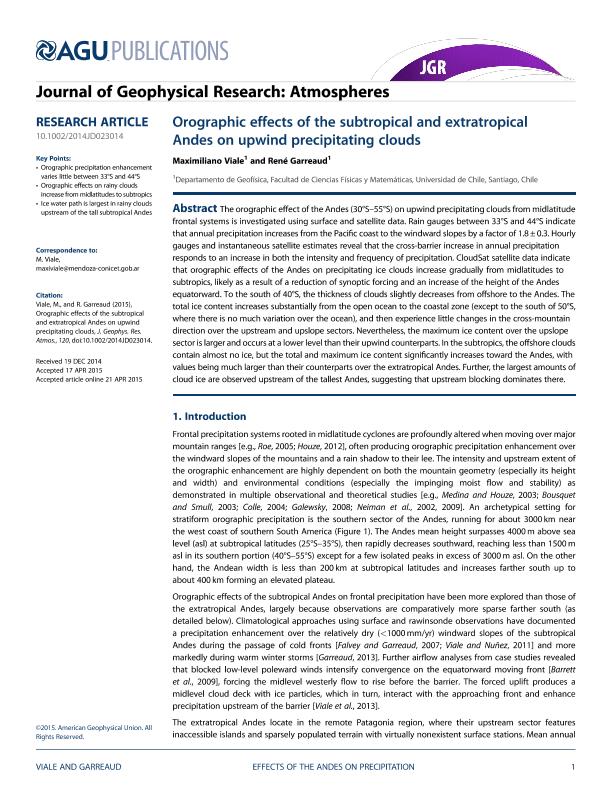Artículo
Orographic effects of the subtropical and extratropical andes on upwind precipitating clouds
Fecha de publicación:
05/2015
Editorial:
American Geophysical Union
Revista:
Journal of Geophysical Research
ISSN:
0148-0227
Idioma:
Inglés
Tipo de recurso:
Artículo publicado
Clasificación temática:
Resumen
The orographic effect of the Andes (30°S–55°S) on upwind precipitating clouds from midlatitude frontal systems is investigated using surface and satellite data. Rain gauges between 33°S and 44°S indicate that annual precipitation increases from the Pacific coast to the windward slopes by a factor of 1.8 ± 0.3. Hourly gauges and instantaneous satellite estimates reveal that the cross-barrier increase in annual precipitation responds to an increase in both the intensity and frequency of precipitation. CloudSat satellite data indicate that orographic effects of the Andes on precipitating ice clouds increase gradually from midlatitudes to subtropics, likely as a result of a reduction of synoptic forcing and an increase of the height of the Andes equatorward. To the south of 40°S, the thickness of clouds slightly decreases from offshore to the Andes. The total ice content increases substantially from the open ocean to the coastal zone (except to the south of 50°S, where there is no much variation over the ocean), and then experience little changes in the cross-mountain direction over the upstream and upslope sectors. Nevertheless, the maximum ice content over the upslope sector is larger and occurs at a lower level than their upwind counterparts. In the subtropics, the offshore clouds contain almost no ice, but the total and maximum ice content significantly increases toward the Andes, with values being much larger than their counterparts over the extratropical Andes. Further, the largest amounts of cloud ice are observed upstream of the tallest Andes, suggesting that upstream blocking dominates there.
Palabras clave:
Precipitating Clouds
,
Orographic Effects
,
Andes
,
Stratiform Precipitation
Archivos asociados
Licencia
Identificadores
Colecciones
Articulos(IANIGLA)
Articulos de INST. ARG. DE NIVOLOGIA, GLACIOLOGIA Y CS. AMBIENT
Articulos de INST. ARG. DE NIVOLOGIA, GLACIOLOGIA Y CS. AMBIENT
Citación
Viale, Maximiliano; Garreaud, René; Orographic effects of the subtropical and extratropical andes on upwind precipitating clouds; American Geophysical Union; Journal of Geophysical Research; 120; 10; 5-2015; 4962-4974
Compartir
Altmétricas




